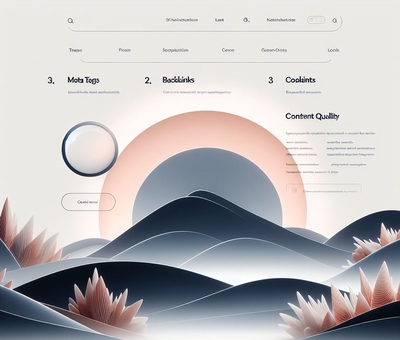
THE IMPORTANCE OF SEO OPTIMIZATION IN WEB DESIGN
In today's digital landscape, the success of a website hinges on its visibility to search engines and potential visitors. This blog explores the crucial role of SEO optimization in web design. From enhancing website ranking and driving organic traffic to maximizing user engagement and conversions, SEO plays a pivotal role in unlocking the full potential of a website. Discover key strategies and best practices for seamlessly integrating SEO techniques into your web design process to achieve long-term success.
In the ever-evolving realm of online presence, the concept of "build it and they will come" no longer holds true. With millions of websites vying for attention on the internet, simply creating a visually appealing and functional website is not enough to ensure its success. Instead, web designers and developers must prioritize Search Engine Optimization (SEO) optimization to enhance visibility, drive organic traffic, and ultimately achieve their desired goals.
This comprehensive guide delves into the critical role of SEO optimization in web design and provides actionable insights for integrating SEO best practices into your web development process.
Understanding the Importance of SEO Optimization:
♦ SEO optimization is the practice of optimizing various elements of a website to improve its ranking on search engine results pages (SERPs) and attract organic traffic.
♦ A high-ranking website is more likely to receive clicks and visitors, leading to increased brand visibility, credibility, and ultimately, conversions.
Key Elements of SEO Optimization in Web Design: a. Website Structure and Navigation:
b. Keyword Research and Integration:
c. On-Page Optimization:
d. Mobile Responsiveness:
e. Site Speed and Performance:
♦ A well-organized website structure with clear navigation enhances user experience and helps search engine crawlers navigate and index the site more efficiently.
♦ Implementing a logical hierarchy of pages and categories ensures that users and search engines can easily find and access relevant content.
♦ Conducting thorough keyword research helps identify the terms and phrases users are searching for related to your industry, products, or services.
♦ Integrating relevant keywords strategically into website content, meta tags, URLs, and headings helps improve search engine visibility and relevance.
♦ Optimizing on-page elements such as title tags, meta descriptions, headings, and image alt text improves the website's visibility and click-through rates on search engine results pages.
♦ Writing compelling and descriptive meta tags entices users to click on your website, increasing organic traffic.
♦ With the increasing use of mobile devices for internet browsing, ensuring that your website is mobile-friendly is crucial for SEO optimization.
♦ Mobile-responsive design improves user experience and helps websites rank higher in mobile search results.
♦ Search engines prioritize websites that load quickly and provide a seamless browsing experience.
♦ Optimizing website performance by reducing page load times, optimizing images, and minimizing server response times improves user satisfaction and SEO rankings.
Integrating SEO Optimization into the Web Design Process: a. Collaborative Approach:
b. Content Strategy:
c. Continuous Monitoring and Optimization:
♦ Effective SEO optimization requires collaboration between web designers, developers, content creators, and SEO specialists from the initial stages of website planning and design.
♦ By involving SEO experts early in the process, potential issues can be addressed proactively, ensuring a well-optimized website from the start.
♦ Developing a comprehensive content strategy that aligns with targeted keywords and addresses the needs and interests of the target audience is essential for SEO success.
♦ High-quality, relevant, and engaging content not only attracts organic traffic but also establishes authority and credibility in the eyes of search engines.
♦ SEO optimization is an ongoing process that requires regular monitoring and optimization to adapt to changing algorithms and user behavior.
♦ Analyzing website performance metrics, monitoring keyword rankings, and making data-driven optimizations ensure sustained visibility and growth.
Measuring the Impact of SEO Optimization:
♦ Utilizing web analytics tools such as Google Analytics and Google Search Console helps track key performance indicators (KPIs) related to SEO, such as organic traffic, keyword rankings, click-through rates, and conversion rates.
♦ By analyzing these metrics regularly, web designers and marketers can assess the effectiveness of their SEO efforts and make informed decisions to further optimize their websites.
In conclusion, SEO optimization is a fundamental aspect of web design that directly impacts a website's visibility, traffic, and success in achieving its goals. By integrating SEO best practices into the web design process, businesses can enhance their online presence, attract organic traffic, and ultimately drive conversions. Embracing a collaborative approach, developing a comprehensive content strategy, and continuously monitoring and optimizing website performance are essential steps toward unlocking the full potential of SEO optimization in web design.
